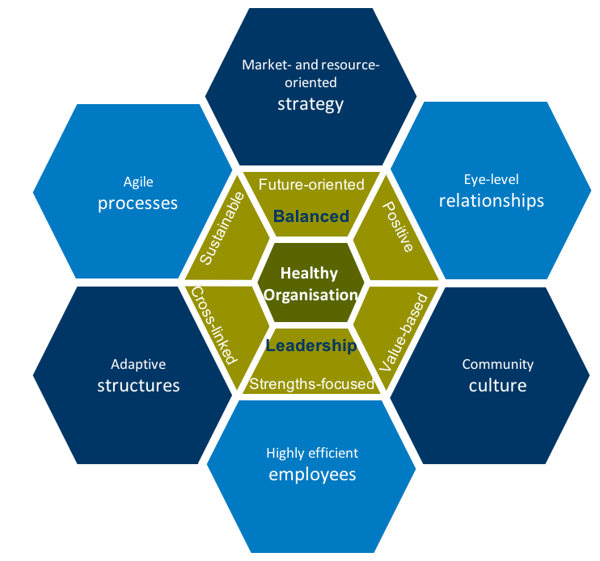Dimensions and factors of a healthy corporate culture
How you can analyse your organisational culture and develop it sustainably
Change management often focuses on the question of which strategies are suitable for building an organization in such a way that open communication and a transparent exchange of information are taken for granted. In order to initiate a change process towards a "healthy organization", a thorough analysis of the status quo is required in advance. But which dimensions are of importance here and are particularly involved in shaping the corporate culture?
Dimensions for the analysis of the corporate culture
In order to understand the status quo of a corporate culture, you can observe the behavior of managers. Their interaction with colleagues and employees allows deep insights into the current organizational culture. Do these still traditional values, which tend to result in hierarchical structures rather than transparency, follow suit, or do they behave in a spirit of partnership towards their employees?
The approach to decision-making processes also has an important dimension: are they centralized, so that decisions are made at the top and executed at the bottom, or is there a consensus-driven process? What about communication between managers and employees in general? How do employees communicate with each other?
The learning and development potential is also a crucial analytical dimension. Are employees encouraged by their managers to develop themselves further or do further training measures play a rather marginal role? To what extent are learning and development opportunities available and how much time is allocated for them all says a lot about an organization's culture.
Last but not least, the willingness to change is per se one of the most important characteristics. If change is welcomed and a suitable process is worked out, the first and most important step towards a healthy, efficient organisation is taken.

Figure: Healthy Organisation (Kallenbach 2016)
After an in-depth analysis, the question now arises as to what kind of change should be shaped in order for a company to be successful in the long term. The following success factors are decisive:
Market- and resource-oriented strategy:
Not only the sense and survival of an organization is ensured, but also the responsibility towards employees, customers, society and the environment is taken into account. A balance between turnover, profit and sustainability is crucial here.
Relationships at eye level:
Internally, relationships are characterised by cooperation, mutual trust, support and commitment. To the outside world through fair dealings with stakeholders, adherence to "compliance rules", recognition of diversity, and assumption of social responsibility.
Community culture:
Characteristic is the life of shared values on the one hand and the acceptance of values that deviate from them on the other. The challenge therefore lies in finding an appropriate balance between tolerance and sanctioning. It can be helpful to build up the organization in such a way that communal behavior is favored and noncommunity behavior is made more difficult.
Efficient employees:
Healthy and committed employees increase productivity and are less absent at the same time. They work in an environment in which they can optimally develop their potential. The work is experienced as meaningful, they receive recognition for their achievements, participate in the success of the company and are socially integrated.
Adaptive structures:
High adaptability allows customer-oriented thinking, feeling and acting, speed and intelligent decisions by employees as well as the development of existing potentials through co-creative processes. Lean and decentralized structures equip the teams with a high degree of personal responsibility.
Agile processes:
Agile processes contribute to motivation, added value, dynamics and quality. They enable lean production, avoid mistakes, waste resources and work in networks. Projects are implemented step by step in manageable time periods in a constant interaction between the participants.
Building a healthy culture - cultural analysis with the GO Gesundheits-Check© (health check)
Depending on the size and degree of cultural change that you want to achieve, there are a variety of tools that can help you to analyze your culture in a structured way and to further develop it with regard to a target image. The GO Health Check© provides you with an initial assessment of how "healthy" your company is today. With our online test you can determine the maturity level of your organisation and get first clues and impulses as to how far you are on the way to a "healthy organisation". A detailed, written analysis is carried out according to the dimensions of strategy, structures, culture, processes, relationships, employees and leadership.
Conclusion
At the beginning of every change process, an analysis of the respective status quo is required. The behaviour of managers and communication within the company are significant indicators for this. In addition, the success factors of a "healthy organization" provide a tailor-made blueprint for successively developing a healthy corporate culture.
(Editorial realization: Corinna Brucker)
Are you interested in change management or would you like to find out more about the Healthy Organization or the GO Health Check©? Then you are welcome to inform yourself about our services in this area or simply contact us.
Literature
Kallenbach, Ingo (2016). Leading in the healthy organization. Exceptional performance through potential development. Stuttgart: Schäffer-Poeschel.

